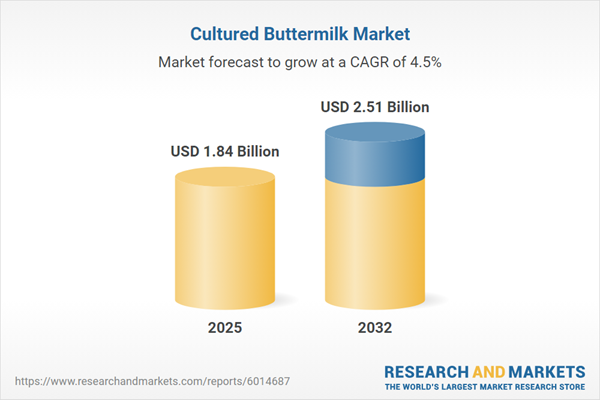Speak directly to the analyst to clarify any post sales queries you may have.
Senior executives face unprecedented complexity in the cultured buttermilk market, where evolving consumer demands, regulatory requirements, and sustainability expectations challenge existing strategies. In this environment, actionable market research is fundamental for strengthening long-term positioning and operational agility.
Market Snapshot: Cultured Buttermilk Market Size and Growth
The cultured buttermilk market is valued at USD 1.76 billion and is projected to reach USD 2.51 billion by 2032, with a compound annual growth rate (CAGR) of 4.53%. This growth is driven by increasing consumer preference for functional dairy and health-focused products. Organizations are actively expanding their product offerings, particularly through the development of probiotic beverages and health-oriented product lines. These initiatives support portfolio diversification and enable firms to adapt offerings to regional trends. Meanwhile, sustainability is now a central focus in both retail and foodservice supply chains, influencing operational strategies and prompting alignment with long-term environmental goals.
Scope & Segmentation: Cultured Buttermilk Market
For senior decision-makers, precise segmentation enables data-driven prioritization of product development, distribution partnerships, and market entry strategies. Each segment underscores areas where companies can enhance their competitive edge and support evolving customer needs.
- Product Types: Conventional, flavored, low-fat, and organic options meet the full spectrum of nutritional preferences across diverse customer profiles and geographies.
- Forms: Liquid and powder formats deliver flexibility for on-premise foodservice, commercial manufacturing, and broader culinary applications, catering to shifting usage patterns.
- Packaging Types: Bottles, cartons, pouches, and Tetrapak formats address both institutional bulk requirements and convenience for end-users, while supporting the shift toward sustainable materials.
- Distribution Channels: Supermarkets, hypermarkets, convenience retailers, specialty outlets, and e-commerce platforms enable cross-channel expansion and greater accessibility for business and consumer clients.
- End Users: Bakeries, cafes, restaurants, hotels, and households require tailored packaging and distribution, fostering customer value and ensuring operational efficiency.
- Geographic Regions: Americas, Europe, Middle East & Africa, and Asia-Pacific offer distinct logistical challenges and regulatory landscapes, requiring market-specific product adaptation and compliance approaches.
Key Takeaways for Senior Market Leaders
- Traceability and transparency in the sourcing of cultured buttermilk are gaining prominence, influencing procurement and purchase decisions as clean-label and natural probiotic attributes become standard expectations.
- Companies are innovating with new flavors and custom product formulations, helping to engage previously underserved markets and meet client-specific dietary requirements.
- Digital procurement and sales platforms are driving faster response times and greater efficiency, allowing organizations to quickly adjust as consumer or regulatory trends shift.
- Sustainable packaging choices are now central to procurement processes, assisting institutional buyers in reducing costs and demonstrating alignment with sustainability commitments.
- Strategic alliances—including collaborations between established brands and newcomers, alongside key foodservice providers—are fast-tracking product innovation and catering to evolving client needs.
- Enterprises are updating internal structures and risk management systems to maintain regulatory compliance and secure supply integrity in dynamic market conditions.
Tariff Impact
Upcoming United States tariffs are encouraging a strategic realignment toward domestic sourcing in the cultured buttermilk market. Organizations are reevaluating logistics and pricing structures to support supply chain resilience and compliance. This shift requires continuous monitoring of operations to sustain growth amid shifting trade dynamics.
Methodology & Data Sources
This report draws from executive interviews, up-to-date industry sources, regulatory insights, and independent third-party analysis. Findings undergo a thorough triangulation to ensure that recommendations are both reliable and actionable for senior leaders seeking market clarity.
Why This Report Matters
- Offers detailed segmentation and regional insights to help optimize investment decisions and facilitate swifter product launches.
- Enables organizations to adopt tailored sustainability, digital transformation, and compliance solutions that address major industry shifts.
- Guides the alignment of strategic business goals with changing market and stakeholder requirements, strengthening market resilience and competitive standing.
Conclusion
Staying ahead in the cultured buttermilk market demands decisive action based on timely intelligence. This report equips decision-makers to capture new opportunities and maintain robust growth amid evolving industry dynamics.
Additional Product Information:
- Purchase of this report includes 1 year online access with quarterly updates.
- This report can be updated on request. Please contact our Customer Experience team using the Ask a Question widget on our website.
Table of Contents
3. Executive Summary
4. Market Overview
7. Cumulative Impact of Artificial Intelligence 2025
Companies Mentioned
The companies profiled in this Cultured Buttermilk market report include:- Danone S.A.
- Nestlé S.A.
- Groupe Lactalis S.A.
- Arla Foods amba
- Fonterra Co-operative Group Limited
- Royal FrieslandCampina N.V.
- Dairy Farmers of America, Inc.
- The Kraft Heinz Company
- Lifeway Foods, Inc.
- CROPP Cooperative (d/b/a Organic Valley Family of Farms)
Table Information
| Report Attribute | Details |
|---|---|
| No. of Pages | 194 |
| Published | November 2025 |
| Forecast Period | 2025 - 2032 |
| Estimated Market Value ( USD | $ 1.84 Billion |
| Forecasted Market Value ( USD | $ 2.51 Billion |
| Compound Annual Growth Rate | 4.5% |
| Regions Covered | Global |
| No. of Companies Mentioned | 11 |









